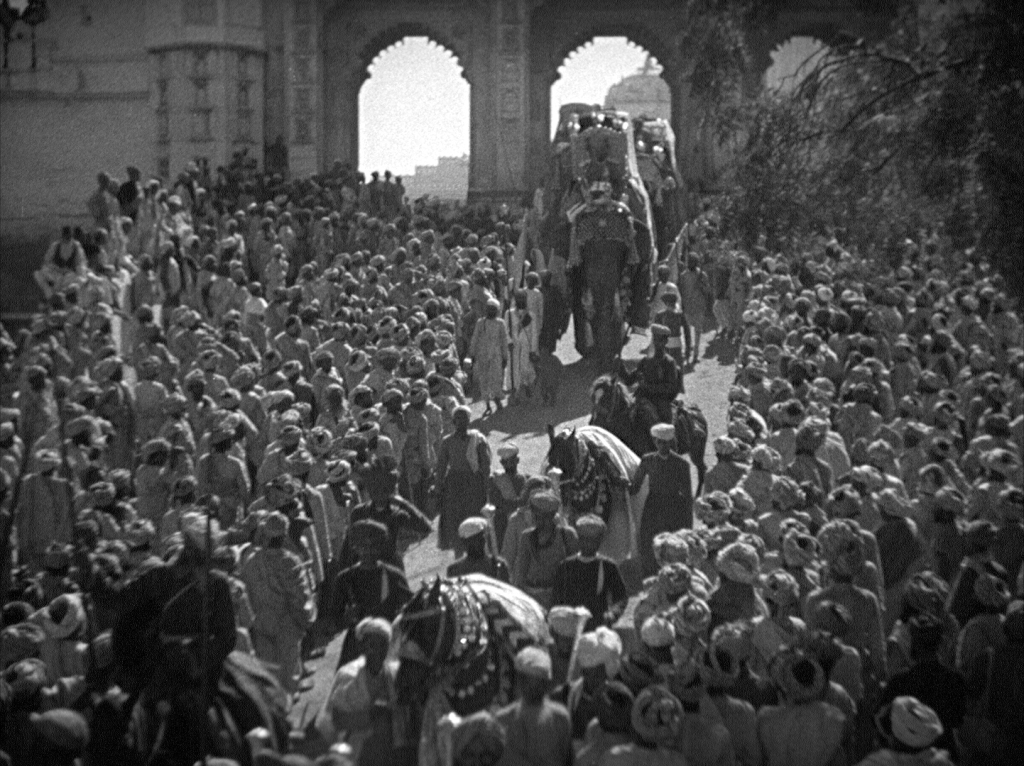Prapancha Pash / A Throw of Dice
Posted by keith1942 on April 21, 2013
 This was the third collaboration between German film director Franz Osten and Indian film Producer Himanasu Rai. Rai was both an actor and producer and later set up the famous Bombay Talkies. Their three films Prem Sanyas / Light of Asia (1925), Shiraz (1928) and A Throw of Dice (1929) all offer fairly free adaptation of Indian mythical stories. They are by the standards of the time fairly opulent with substantial funding. A Throw of Dice was the most opulent and expensive, with a reputed 10,000 extras involved in the production. They were officially international productions, with Rai pre-selling the rights, hence the involvement of UFA and the British entrepreneur H B Woolfe. But the films also enjoyed support and resources from various Indian princes and Rajahs [Jaipur, Udaipur and Mysore], hence the impressive locations in the films.
This was the third collaboration between German film director Franz Osten and Indian film Producer Himanasu Rai. Rai was both an actor and producer and later set up the famous Bombay Talkies. Their three films Prem Sanyas / Light of Asia (1925), Shiraz (1928) and A Throw of Dice (1929) all offer fairly free adaptation of Indian mythical stories. They are by the standards of the time fairly opulent with substantial funding. A Throw of Dice was the most opulent and expensive, with a reputed 10,000 extras involved in the production. They were officially international productions, with Rai pre-selling the rights, hence the involvement of UFA and the British entrepreneur H B Woolfe. But the films also enjoyed support and resources from various Indian princes and Rajahs [Jaipur, Udaipur and Mysore], hence the impressive locations in the films.
The film opens with a title card: “All Quiet in the Jungle.” We see a hunting party and startled animals, including snakes, monkeys and birds. In the jungle is a hut occupied by a healer and his daughter Sunita. The healer was once at the court of King Ranjit but left because of its vices. We now meet Ranjit with his hunting partner King Sohat. We soon see that they are obsessive gamblers, preferring to throw dice to hunting the abundant game. Ranjit is plotting to kill Sohat, but this plan misfires when the efforts of the healer and Sunita save Sohat. Both kings now become smitten with Sunita.
To Ranjit’s chagrin Sunita favours Sohat. Sohat now returns to his palace with Sunita and makes preparations for their marriage. Still obsessed with Sunita Ranjit plots to wreck their love. First he plants evidence that suggests that Sohat has murdered Sunita’s father. She leaves the palace but returns when Sohat’s innocence is revealed. So Ranjit attends the wedding and inveigles Sohat into another game of dice. He uses loaded dice and finally in a desperate gamble Sohat becomes his slave. However, one of the palace children unwittingly reveals the secret of the dice. Exposed Ranjit flees from Sohat and falls to his death. Sohat and Sunita are together on the skyline as the sun sinks below the horizon.
The plot is simple but the film is far more complex. It is also impressive. Much of this effect is due to the actual locations, with grandiose palaces, teeming streets and riversides and the rich fauna and animal life of the jungle. There are numerous elephants, tigers and later in the film camels. And the set pieces have massive crowds and beautifully rendered costumes, sets and props.
Equally impressive is the cinematography. The lighting cameraman on the film was Osten’s fellow German Emil Schunneman. The cinematography is sharp and clear, well served by a BFI restoration from 2006. The film uses techniques recognisable from the German industry, including impressive deep focus. There are frequent soft focus shots and effective backlighting setting off the star players. There is one striking tracking shot during the climatic sequence, which must have been technically very difficult. The final shot of Sohat and Sunita uses striking contrast as they stand on the skyline and the sun sinks away. This last technique seems to have become a regular of Indian films: Mother India (1957), screened in the same series, has a number of similar and equally effective shots.
The film’s qualities stem from a successful partnership between Osten, Rai and their regular storywriter Niranjan Pal. The production values are way ahead of surviving Indian films of the period. In fact, they rival some of the best work from the great Ufa studio. And they are certainly superior to the British films in which Woolfe invested funds.
The screening at Bradford International Film Festival was on a DCP. It included a recorded score composed by Nitin Sawhney. This uses the London Symphony Orchestra augmented by flutes and tabla percussion. It also uses the human voice, developing as the story progresses. In the early stages it is simple humming, this develops at one point into scat singing and finally fully realised vocals. The score is extremely effective. I thought it was probably too strong at moments of melodrama but one accustoms to it as the film progresses.
The screening ran for 78 minutes. When the film was screened at the 13th Giornate del Cinema Muto in 1994 it ran 85 minutes, 6695 feet at 21 fps. The digital version seemed to run fine and seemed complete. However, the Giornate print was from the Indian Archive. It may well be that the various versions [domestic and exported to Germany and the UK] were different. But it also seems that this international distribution is one reason why the three Osten/Rai films survive. Most other Indian productions of the period have been lost.
Indian Silent Cinema « Early & Silent Film said
[…] from the British film industry. The final and most sumptuous of these epics was Prapancha Pash / A Throw of the Dice (1929). The film retells an episode from the Mahabharata about a king who is cheated of his throne […]